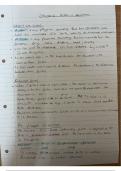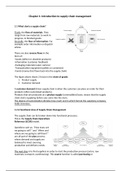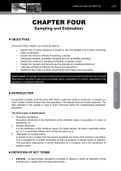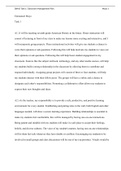Table of Contents
Introduction.................................................................................................................................................. 2
Ethyl ethanoate............................................................................................................................................ 2
Reflux........................................................................................................................................................... 2
Reflux: laboratory................................................................................................................................................2
Reflux: industries..................................................................................................................................................3
Distillation.................................................................................................................................................... 3
Distillation: laboratory.........................................................................................................................................4
Distillation: industries..........................................................................................................................................5
Solvent extraction......................................................................................................................................... 6
Liquid-liquid extraction........................................................................................................................................6
Use of chemicals to remove impurities.......................................................................................................... 6
Manufacturing ethyl ethanoate..................................................................................................................... 8
Laboratory scale..................................................................................................................................................8
Yield........................................................................................................................................................... 12
Percentage yield......................................................................................................................................... 13
Industrial scale............................................................................................................................................ 14
Factors affecting yield................................................................................................................................. 15
Boiling point............................................................................................................................................... 16
Purity.......................................................................................................................................................... 17
Siwoloboff method.............................................................................................................................................17
Infrared spectroscopy................................................................................................................................. 18
Gas chromatography................................................................................................................................... 21
High-performance liquid chromatography (HPLC)........................................................................................22
Comparing laboratory methods to test purity.............................................................................................. 24
Comparing industrial methods to test purity............................................................................................... 24
Bibliography............................................................................................................................................... 25
1
,Introduction
In this report, I will look at organic liquid manufacturing procedures and testing
methods. I'm going to make and test a small ester called ethyl ethanoate. A non-
hydrocarbon organic molecule formed when an alcohol reacts with a carboxylic
acid is known as an ester. I'm going to make this organic liquid in a school
laboratory and see how different it is from an industrial method. I'll also
investigate whether the end result and purity are influenced by the different
surroundings and process.
Ethyl ethanoate
Esters are non-hydrocarbon chemical compounds that are formed when a
carboxylic acid reacts with an alcohol. They can be found in nature and can also
be made synthetically. Fatty acids and glycerol, as well as pheromones and fruit
scents, contain natural esters. Smaller esters have lower boiling temperatures
and are more volatile than larger esters. Small esters are water soluble, but as
the carbon chain length increases, solubility diminishes. Ethyl ethanoate is one
of the most regularly utilised small esters (C4H8O2). It's a flammable, colourless
liquid with a pleasant odour that's used in fragrances, flavourings, and
medications. Ethyl ethanoate is also an organic solvent that is commonly found
in nail polish removers and lacquer thinners. It has evaporative qualities due to
its low boiling point, making it helpful in plasticisers and glues.
Reflux
Reflux is a chemistry term for a device that heats a substance without
releasing the solvent. The apparatus was built vertically to make the
boiling and condensing process easier. The liquid boils and condenses
simultaneously in the reflux mechanism. Organic compounds are
subjected to refluxing because they have low boiling temperatures and
can be volatile or evaporate quickly into the surroundings. As a result, the
reflux method is employed to avoid liquid loss. This permits the liquid to
return to its original state without having to be discarded. Reflux activates
the solvent if it has a boiling point of 100oC and the mixture has a boiling
point of 80oC. Reflux retains a liquid's original properties while limiting its
volume loss. Reflux involves heating a chemical reaction for a set length
of time while employing a condenser to continuously cool the vapour
produced back into liquid form. Vapours created above the reaction
condense and return to the flask as a condensate. It ensures that the
reaction temperature remains constant in this manner. Solids and liquids,
or both, can be used as reactants in reflux experiments. The boiling points
of the solvents and the reflux ring determine the temperature at which
the reaction is heated. A fraction of the solvent goes up the condenser
tube during the reaction before condensing into the flask. The condenser's
inner jacket will appear to be dry above this point. The solvent returns to
the flask once it reaches this point. The reflux ring is the dividing line
between these two parts. The reaction temperature should be chosen so
that the reflux ring is only a third to halfway up the condenser.
Reflux: laboratory
In chemistry laboratory classes, one of the most frequent approaches is
reflux. Because many covalent compound reactions are gradual and not
instantaneous, continuous heating drives the equilibrium to produce an
2
, adequate amount of product. The reactants are dissolved or suspended in
a suitable solvent, which is then heated before being condensed and
returned to the reaction flask in the reflux process. Once set up, a reflux
reaction can be performed for minutes, hours, or even days to achieve the
desired result. Reflux equipment is easy to put together. This is useful in
the laboratory, especially in educational settings when the people
handling the equipment may have little or no familiarity with it. The
equipment resembles those used in distillation procedures. A heat source,
such as a Bunsen burner, heating mantle, and water bath, a pear-shaped
flask, a thermometer, and a condenser, are all part of the apparatus in
question. A Y-adapter connected to a condenser attached to a receiving
flask is also utilised during reflux.
Reflux: industries https://bit.ly/38mRiZO
Large-scale industries like petroleum refineries use
refluxing. It's applied in a simple apparatus made up of
a round-bottomed flask, a condenser, a water bath,
and a heat source at the laboratory scale. The round-
bottomed flask receives a mixture of reactants and the
solvent. It's attached to a lengthy condenser that's
open at the top. The reaction mixture begins to boil
when the round-bottomed flask containing the
components is heated in a water bath. The
combination yields vapours. The condenser collects
and condenses this vapour. The droplets then fall back
into the reaction mixture due to gravity. The chemical
process will be thermally accelerated using this
strategy. The reaction takes place at a temperature
and pressure that are chemically regulated. When
compared to laboratory equipment, the device is Figure 1 is showing us an
substantially larger and more complicated. In example of how reflux is
utilised in industries.
contrast to the simpler apparatus used in
laboratories, which can be handled by anyone, the machinery would
require someone qualified or skilled to deal with it.
Distillation
Distillation is a typical method for separating mixtures based on changes
in the conditions required to shift the phase of the constituents in the
mixture. The combination can be separated by heating the liquid to force
components with different boiling points into the gas phase. The gas is
then collected after it has been condensed back into liquid form. Double
distillation is the technique of repeating the procedure on the collected
liquid to improve product purity. Although the phrase is most usually
associated with liquids, it can also be used to separate gases by liquefying
components using temperature and/or pressure variations. Simple and
fractional distillation are two of the many types of distillation methods
available.
3











